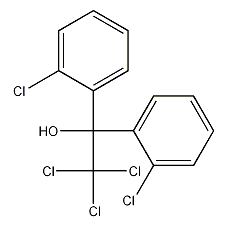tricloxil


Structural formula
| Business number | 037X |
|---|---|
| Molecular formula | C14H9Cl5O |
| Molecular weight | 370.49 |
| label |
1,1-bis(p-chlorophenyl)-2,2,2-trichloroethanol, Dicofol, 1,1-bis(p-chlorophenyl)-2,2,2-trichloroethanol, 1,1-bis(4-chlorophenyl)-2,2,2-trichloroethanol, Dicofol, 1,1-Bis(4-chlorophenyl)-2,2,2-trichloroethanol, 2,2,2-Trichloro-1,1-bis(4-chlorophenyl)ethanol, acaricides, pesticides |
Numbering system
CAS number:115-32-2
MDL number:MFCD00055271
EINECS number:204-082-0
RTECS number:DC8400000
BRN number:1886299
PubChem ID:None
Physical property data
1. Properties: White solid, industrial product is brown and sticky.
2. Density (g/mL, 25℃): 1.45
3. Relative vapor density (g/mL, air=1) undetermined:
p>
4. Melting point (ºC): 78.5~79.5
5. Boiling point (ºC, normal pressure): 180
6. Boiling point (ºC, KPa): Undetermined
7. Refractive index (n20/D): Undetermined
8. Flash point (ºC): Undetermined
9. Specific rotation (ºC): Undetermined
10. Autoignition point or ignition temperature (ºC): Undetermined Determined
11. Vapor pressure (mmHg, 38ºC): Undetermined
12. Saturated vapor pressure (kPa, ºC): Undetermined
13. Combustion Heat (KJ/mol): Undetermined
14. Critical temperature (ºC): Undetermined
15. Critical pressure (KPa): Undetermined
16. The logarithmic value of the oil-water (octanol/water) partition coefficient: Undetermined
17. The upper explosion limit (%, V/V): Undetermined
18. The lower explosion limit ( %, V/V): Undetermined
19. Solubility: Soluble in most aliphatic and aromatic solvents, almost insoluble in water.
Toxicological data
The acute oral LD50 for male rats is 809mg/kg and for females is 684mg/kg. The acute percutaneous LD50 in rabbits is 1870mg/kg. Concentration of 300mg/kg dichloride was fed to dogs for 1 year, and no poisoning was found. Carp LC50 1.lmg/L (48h), does not harm natural enemies.
Ecological data
None
Molecular structure data
5. Molecular property data:
1, Molar refractive index: 85.61
2, Molar volume (cm3/mol): 241.8
3, Isotonic specific volume (90.2K): 648.8
4. Surface tension (dyne/cm): 51.8
5. Polarizability (10-24cm3) :33.93
Compute chemical data
1. Reference value for hydrophobic parameter calculation (XlogP): None
2. Number of hydrogen bond donors: 1
3. Number of hydrogen bond acceptors: 1
4. Number of rotatable chemical bonds: 2
5. Number of tautomers: none
6. Topological molecule polar surface area 20.2
7. Number of heavy atoms: 20
8. Surface charge: 0
9. Complexity: 292
10. Number of isotope atoms: 0
11. Determine the number of atomic stereocenters: 0
12. Uncertain number of atomic stereocenters: 0
13. Determine the number of chemical bond stereocenters: 0
14. Number of uncertain chemical bond stereocenters: 0
15. Number of covalent bond units: 1
Properties and stability
It hydrolyzes into dichlorobenzophenone and chloroform when exposed to alkali, and can be mixed with all pesticides except strongly alkaline pesticides. Stable under acidic conditions and easily hydrolyzed in alkaline media.
Storage method
None
Synthesis method
Chlorine DDT and then acidically hydrolyze it to obtain dicofol.
1. Chlorination: Use dichloroethane as the solvent, add 1% azobisisobutyronitrile as the catalyst, and pass it in at 80~90℃ The chlorine gas reacted for 2 hours, and then the solvent was evaporated under reduced pressure.
2.Hydrolytic chlorination product hydrolysis reaction in p-toluenesulfonic acid 33%, sulfuric acid 33%, water 33% % mixed acidic medium, with arylsulfonic acid or lower alkylsulfonic acid as accelerator, react at 135-150°C for 5-6 hours, and then add an appropriate amount of low-boiling point solvent dichloroethane and water to form an oil-water mixture. layer, extract the oil layer, wash it with dilute alkali solution and water, and then evaporate the solvent under reduced pressure to obtain dicofol original drug.
Purpose
1. Contact acaricide. Pesticide residue analysis standards.
2.Broad-spectrum acaricide , effective against adult mites, juvenile mites and eggs. It has good selectivity, does not harm natural enemies, and is safe for bees. It mainly kills harmful mites by contact, has a long residual effect and has no systemic effect. Used to control various harmful mites on cotton, fruit trees and flowers. Resistance may develop after years of use. When using, spray 20% emulsifiable concentrate 800 to 1500 times of water evenly. When using for the first time or when the temperature is high, the dilution factor can be increased.
